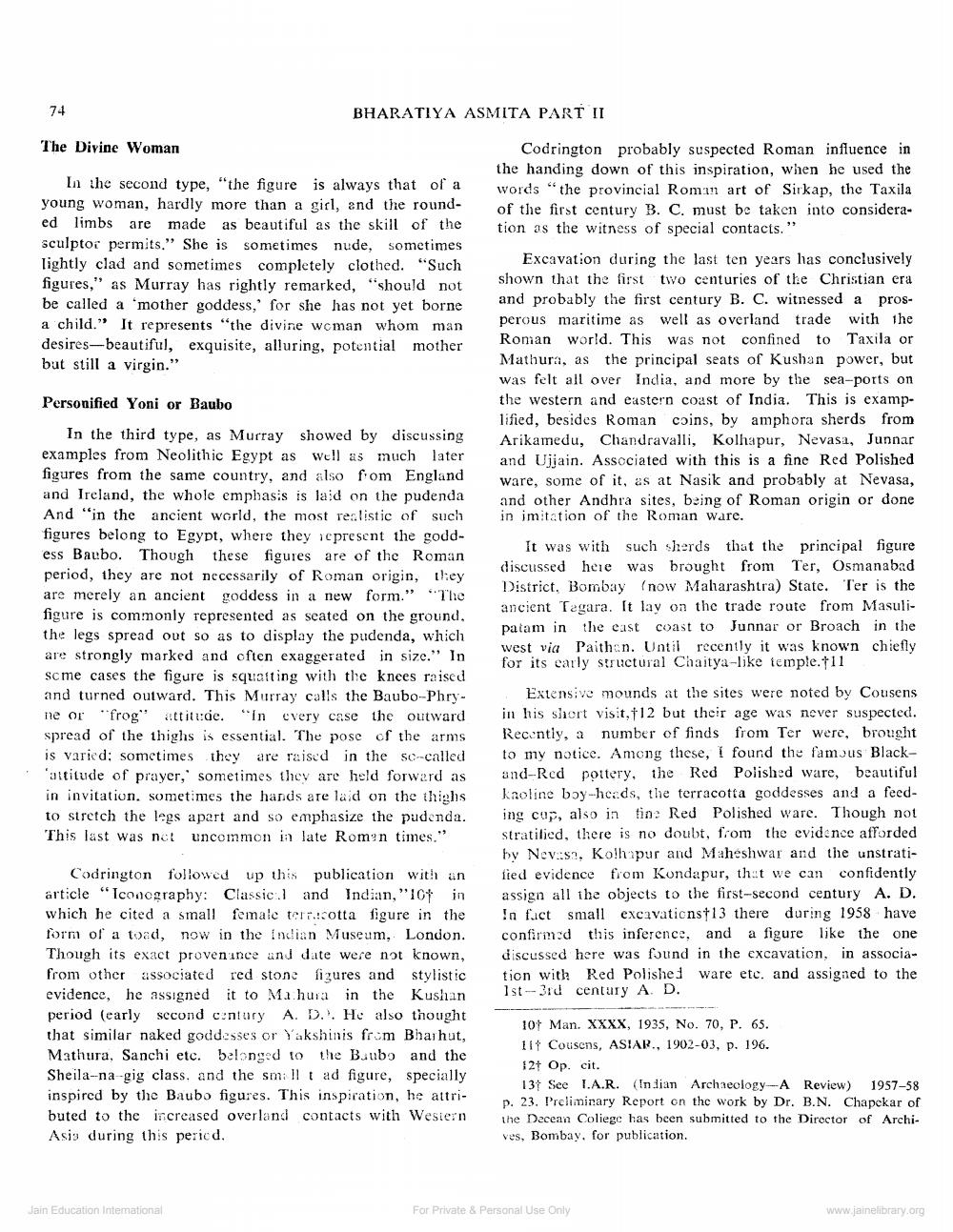________________
74
BHARATIYA ASMITA PART II
The Divine Woman
In the second type, "the figure is always that of a young woman, hardly more than a girl, and the rounded limbs are made as beautiful as the skill of the sculptor permits." She is sometimes nude, sometimes lightly clad and sometimes completely clothed. "Such figures," as Murray has rightly remarked, "should not be called a 'mother goddess, for she has not yet borne a child." It represents "the divine woman whom man desires-beautiful, exquisite, alluring, potential mother but still a virgin."
Personified Yoni or Baubo
In the third type, as Murray showed by discussing examples from Neolithic Egypt as well as much later figures from the same country, and also from England and Ireland, the whole emphasis is laid on the pudenda And "in the ancient world, the most realistic of such figures belong to Egypt, where they represent the goddess Baubo. Though these figures are of the Roman period, they are not necessarily of Roman origin, they are merely an ancient goddess in a new form." "The figure is commonly represented as seated on the ground, the legs spread out so as to display the pudenda, which are strongly marked and often exaggerated in size." In some cases the figure is squatting with the knees raised and turned outward. This Murray calls the Baubo-Phryne or "frog" attitude. "In every case the outward spread of the thighs is essential. The pose of the arms is varied; sometimes they are raised in the so-called 'attitude of prayer, sometimes they are held forward as in invitation. sometimes the hands are laid on the thighs to stretch the legs apart and so emphasize the pudenda. This last was not uncommon in late Roman times."
Codrington followed up this publication with an article "Iconography: Classic and Indian,"10† in which he cited a small female terracotta figure in the form of a toad, now in the Indian Museum, London. Though its exact provenance and date were not known, from other associated red stone figures and stylistic evidence, he assigned it to Mathura in the Kushan period (early second century A. D.'. He also thought that similar naked goddesses or Yakshinis from Bharhut, Mathura, Sanchi etc. belonged to the Baubo and the Sheila-na-gig class. and the sm: Ilt ad figure, specially inspired by the Baubo figures. This inspiration, he attributed to the increased overland contacts with Western Asia during this period.
Jain Education International
Codrington probably suspected Roman influence in the handing down of this inspiration, when he used the words "the provincial Roman art of Sirkap, the Taxila of the first century B. C. must be taken into consideration as the witness of special contacts."
Excavation during the last ten years has conclusively shown that the first two centuries of the Christian era and probably the first century B. C. witnessed a prosperous maritime as well as overland trade with the Roman world. This was not confined to Taxila or Mathura, as the principal seats of Kushan power, but was felt all over India, and more by the sea-ports on the western and eastern coast of India. This is examplified, besides Roman coins, by amphora sherds from Arikamedu, Chandravalli, Kolhapur, Nevasa, Junnar and Ujjain. Associated with this is a fine Red Polished ware, some of it, as at Nasik and probably at Nevasa, and other Andhra sites, being of Roman origin or done in imitation of the Roman ware.
It was with such sherds that the principal figure discussed here was brought from Ter, Osmanabad District, Bombay (now Maharashtra) State. Ter is the ancient Tagara. It lay on the trade route from Masulipatam in the east coast to Junnar or Broach in the west via Paithan. Until recently it was known chiefly for its early structural Chaitya-like temple.†11
Extensive mounds at the sites were noted by Cousens in his short visit, f12 but their age was never suspected. Recently, a number of finds from Ter were, brought to my notice. Among these, I found the famous Blackand-Red pottery, the Red Polished ware, beautiful kaoline boy-heads, the terracotta goddesses and a feeding cup, also in tin: Red Polished ware. Though not stratified, there is no doubt, from the evidence afforded by Nevasa, Kolhapur and Maheshwar and the unstratified evidence from Kondapur, that we can confidently assign all the objects to the first-second century A. D. In fact small excavations†13 there during 1958 have confirmed this inference, and a figure like the one discussed here was found in the excavation, in association with Red Polished ware etc. and assigned to the 1st-3rd century A. D.
10 Man. XXXX, 1935, No. 70, P. 65. 11 Cousens, ASIAR., 1902-03, p. 196. 12+ Op. cit.
13 See I.A.R. (Indian Archaeology-A Review) 1957-58 p. 23. Preliminary Report on the work by Dr. B.N. Chapekar of the Decean Coliege has been submitted to the Director of Archives, Bombay, for publication.
For Private & Personal Use Only
www.jainelibrary.org




